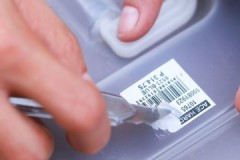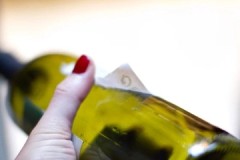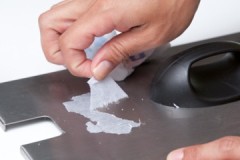Effective and effective ways to remove super glue
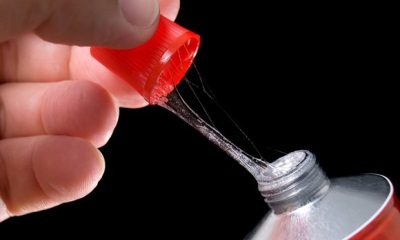 For household repairs requiring reliable bonding of broken parts, superglue is most often used.
For household repairs requiring reliable bonding of broken parts, superglue is most often used.
Suitable for bonding most materials and drying quickly, it provides a reasonably secure bond. But if used inaccurately, it can leave drips and stains that are difficult to remove.
Special preparations and homemade recipes will help to cope with adhesive traces. In this article we will tell you how to remove super glue from various surfaces and objects.
Content
How to Remove a Moment from a Surface: Which Method Should I Choose?
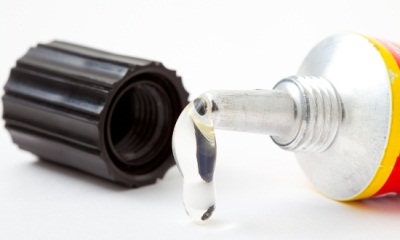 Superglue is a synthetic formulation that comes in liquid form in small, single-use tubes. When applied to a surface, it quickly sets in the air, giving a reliable adhesion to the material.
Superglue is a synthetic formulation that comes in liquid form in small, single-use tubes. When applied to a surface, it quickly sets in the air, giving a reliable adhesion to the material.
The adhesive property is provided by the inclusion in the composition of cyanoacrylate... It is a water-insoluble substance that, when hardened, becomes resistant to mechanical stress and moisture.
To remove the glue, it is necessary to use those means that are able to transfer it from a solid state to a viscous one. This makes the glue easier to remove.
There are several ways to influence the hardened glue:
| Method of exposure | Method essence | Note |
| Mechanical | Physical mechanical impact (cutting, sawing, etc. | Rough mechanical impact can lead to damage to the stained surface. |
| Temperature | High or very low temperature applications | Despite the resistance to temperature fluctuations, targeted heating leads to softening of the composition, and freezing - to its fragility |
| Special means | The use of commercial preparations that are designed to soften the adhesive and remove it | The price of such products is higher than home recipes, and the volume of the purchased product is small |
| Chemicals | Homemade recipes based on drugs available in the household | Many substances that can dissolve superglue are already in the medicine cabinet, in the kitchen or on the farm. |
The best cleaning result can be achieved by using several methods at once, for example, softening the adhesive with chemicals, and subsequent mechanical removal.
How to wipe at home?
The easiest ways to deal with glue on a clean surface are use the tools that are at hand:
- in the kitchen (vinegar, oil, etc.);
- in the medicine cabinet (Dimexidum, alcohol, etc.);
- on the farm (White alcohol, gasoline, etc.).
Acetone
Acetone is a solvent used to remove paint and super glue. The order of work:
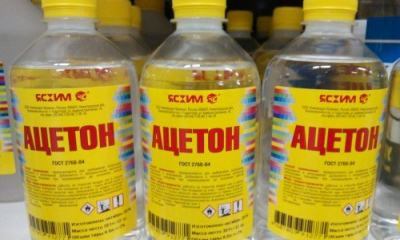 Moisten a napkin with acetone.
Moisten a napkin with acetone.- Moisten the area stained with glue with the solution.
- Allow at least 15 minutes to soften the glue.
- Clean with a scraper.
- Wash the surface.
- Wipe up.
Acetone can smear superglue, so all work must be done as carefully as possible.
White spirit, gasoline
White spirit and refined gasoline are suitable for use as a stain remover for difficult stains and as a solvent for various types of adhesives. To do this, the rags are impregnated with the selected solvent and actively rubbing the surface stained with super glue.
Dimexide
Dimexide is a medicinal product that can be used as a solvent for glue and to remove stains.
Application procedure:
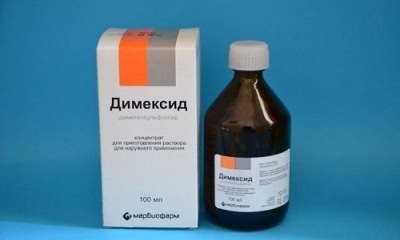 Moisten a napkin with Dimexidum.
Moisten a napkin with Dimexidum.- Wipe the stain with the solution, trying to actively moisturize it. If the glue drip is on a horizontal surface, you can leave the napkin lying at the place of contamination.
- Once the glue begins to soften, clean it off with a plastic scraper.
- Rinse the cleaned surface and wipe dry.
Minus Dimexidum is a pronounced unpleasant odor.
Alcohol
Alcohol-containing solutions can act as a solvent superglue:
- The glue spot is well saturated with alcohol. If possible, rags soaked in alcohol should be left directly on the stain.
- If this is not possible, then after 10 minutes, repeat the application of alcohol.
- The softened superglue composition is scraped off the surface with a scraper.
- The surface is washed.
Soda (salt)
Salt and soda are in powder form. Abrasive qualities allow these substances to exert mechanical action:
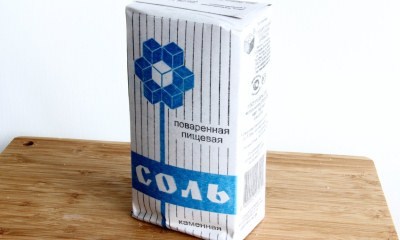 for the best effect, a thick gruel is prepared from soda, which is applied to the problem area;
for the best effect, a thick gruel is prepared from soda, which is applied to the problem area;- slightly rubbing;
- leave the gruel for a while for exposure;
- rubbing again, helping with the work with a plastic scraper.
For large drips, this method is ineffective.
Oil
Vegetable oil or other product that has a high percentage of fat intake will help in cases when nothing else is at hand. The oil must be used in sufficient quantity, it must cover the entire surface of the stain well from the glue.
If the glue mark is located on a vertical surface, then using a rag or cotton swab, oil should be repeatedly applied. After softening, the stain is cleaned off. The surface will need to be additionally treated with a degreasing agent to remove all the fat.
Peroxide
Hydrogen peroxide is suitable for cleaning metal and leather products. To affect the problem area, it is advisable to prepare a compress of peroxide and hold it for a while - until the superglue softens. After that, remove with a scraper.
Vinegar
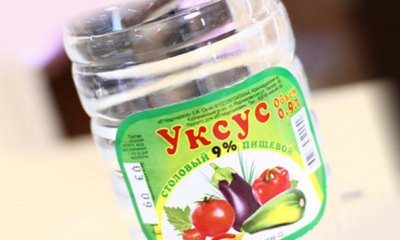 In the composition of table vinegar, acetic acid is present, which, by reacting with superglue, promotes its softening.
In the composition of table vinegar, acetic acid is present, which, by reacting with superglue, promotes its softening.
The technology of work is similar to other methods: pure vinegar is applied to the stain, and after the glue becomes plastic, the final cleaning is carried out.
The use of such a solvent is more productive on relatively fresh adhesive traces, and may not cope with old ones.
Top 3 special products
If simple home methods are ineffective, you can use special purchased drugs. They are distinguished by high efficiency and quick results.
Anticlea Super Moment
"Super Moment Antikley" is one of the most demanded and popular drugscapable of dissolving superglue. It is produced in small tubes with a volume of 5 grams. The product is sold in a sealed tube, which costs about 120 rubles.
Just before use, a cap is screwed onto the tube, which pierces the factory sealed membrane. Using a thin nozzle tip, the anti-glue is applied to the desired area.
The great popularity of antiglue is explained by its advantages:
- efficiency;
- affordable price;
- ease of use.
Despite the small volume of the amount of anti-glue placed in the tube, in general it is enough to remove stains formed from the use of one tube of superglue.
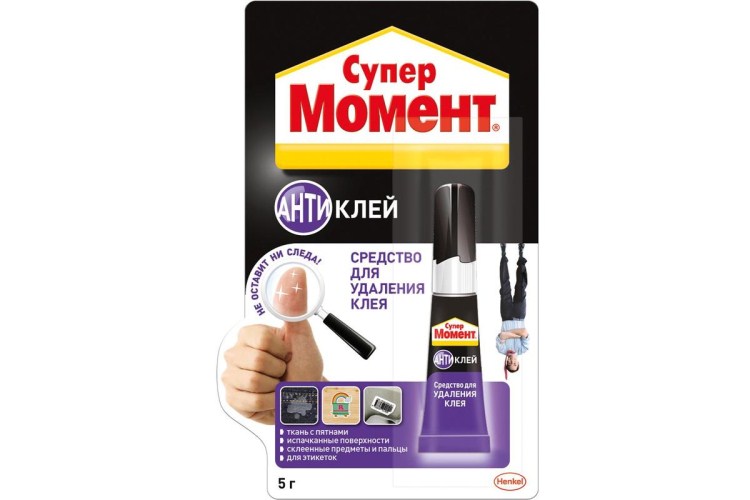
Second Anticlea
The remover has a small package - 3 grams per tube. Cost - from 60 rubles per tube. The tool allows you to remove the stains accidentally left by the glue, to eliminate improper adhesion of materials.
The application is very simple:
- Apply to the surface stained with glue.
- Wait 60 minutes.
- Clean the surface.
It is very easy to use, inexpensive, and effective. But if a large enough area of the object is stained with glue, 2-3 tubes of anti-glue are needed.
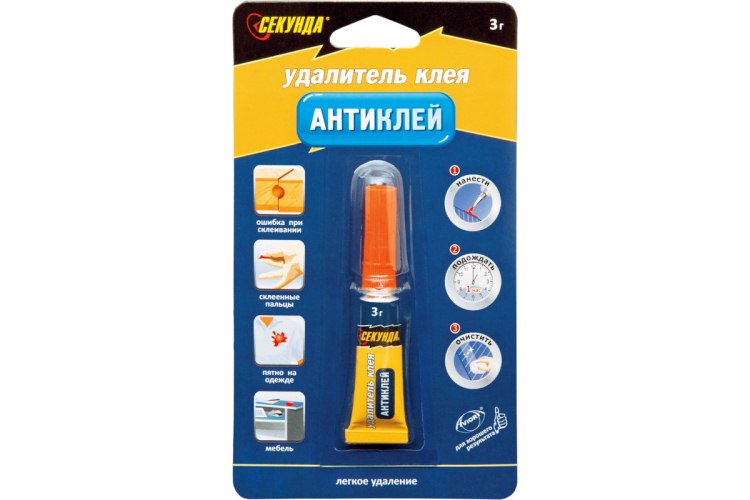
Cleaner Contact
The manufacturer produces the cleaner in two types of packaging:
- A bubble with a brush.
- Tube with attachment.
In both cases, the Contact is well applied and distributed. The drug costs about 100 rubles. A small volume in most cases is sufficient for one use.
If the surface is not cleaned properly the first time, the cleaning can be repeated. This situation can occur with thick old superglue drips.
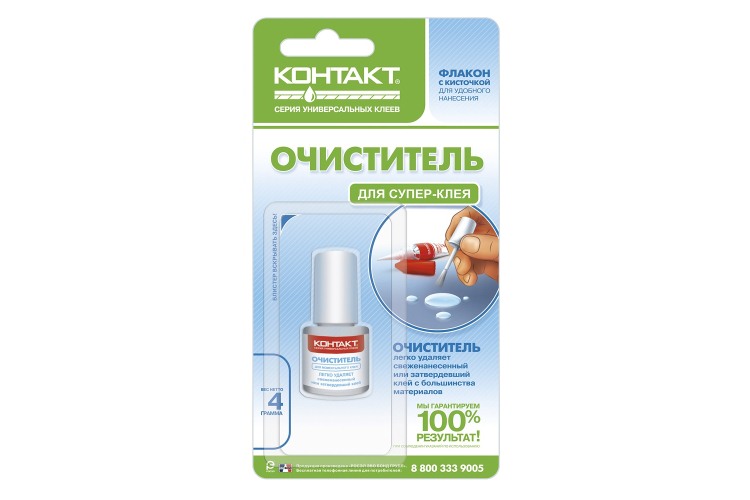
Features of removal, taking into account the type of material
Working with superglue requires extra care. Otherwise, it cannot do without drips, glue droplets and streaks. You can eliminate them in different ways, but it is imperative to take into account the material of the surface that needs cleaning.
Tree
Wooden surfaces differ from each other:
- type of wood;
- presence / absence of additional coating, for example, varnish or paint, etc.
| Wooden surface | Prohibitions | Permissions |
| Varnished or painted with paint | It is not recommended to use solvents that are aggressive in their effect, as well as to exert mechanical stress - this can damage the coating | Oil, other fats |
| Untreated wood surface | Oil, fats | Grinding |
| Chipboard or plywood | Oil, fats | Acetone, vinegar, Dimexide, |
Tile, glass
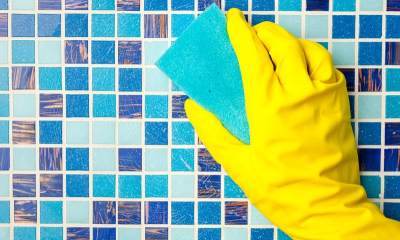 The smooth, non-porous surface of tiles and glass allows you to resort to various methods of cleaning the surface from glue.
The smooth, non-porous surface of tiles and glass allows you to resort to various methods of cleaning the surface from glue.
In addition, a very smooth surface gives a less strong adhesion to the adhesive. Therefore, it will be easier to remove it.
You can use any of the listed chemical methods of exposure., as well as special products that work on the principle of glue dissolution.
Glass and tiles can be easily cleaned of softened glue using a scraper or plastic knife.
The tile and glass surface should not be exposed to intense sharp mechanical stress, for example, impacts, as the material can crack and crack. Read more about removing super glue from glass. here.
Plastic, silicone
The plastic and silicone surface can be super glue cleaned using special means, as well as recipes based on such substances:
- Dimexide (applied for a short time, literally for a couple of minutes);
- petrol;
- White alcohol;
- heating - only for heat-resistant plastic;
- oil, etc.
The plus of silicone is plasticity, this quality can be used by clenching and stretching an object in the process of cleaning it from glue.
There are many types of plastic, so before using the solvent on the surface for the first time, it is advisable to test for the reaction in an inconspicuous area... Read more here.
Fabric things
Textiles stained with glue require special care. Garments or upholstery can be very difficult or even impossible to clean. The type of fabric should be taken into account.
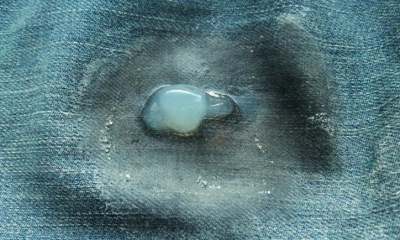 Most often, the following methods are used to clean the material:
Most often, the following methods are used to clean the material:
- Cleaning with acetone, which is suitable for the care of natural fabrics.
- Treatment with an aqueous vinegar solution.
- Using anti-glue.
- Mechanical cleaning with a brush in soapy water, etc.
The thinner the material is stained, the more delicate the processing should be. Read more here.
Suede and leather
Homemade recipes or anti-glue can be used for processing. Try to soften the adhesive layer, and only then remove it.
Among the solvents used, one of the following can be used:
- ammonia;
- acetone;
- petrol.
Metal
For removing super glue from metal objects can be used as a solvent:
- hydrogen peroxide;
- special means;
- Dimexide.
If the surface is painted, it is necessary to check the reaction of the paint to the selected solvent.
Household appliances (TV, phone screen, laptop)
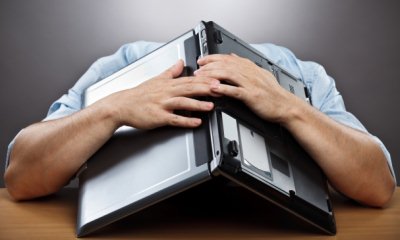 Soiled household appliances are cleaned similarly to plastic recipes. The peculiarity of care is to prevent the solvent from flowing into:
Soiled household appliances are cleaned similarly to plastic recipes. The peculiarity of care is to prevent the solvent from flowing into:
- joints,
- location of buttons,
- switches, etc.
Also, do not use solvents that promote spreading and smearing of the softening adhesive.
Floor
A drop of glue on the floor is quite common. Dealing with the problem is not difficult if you know the type of coverage.
| Coating | Glue Removal Method |
| Laminate | Dimexide |
| Linoleum | Any recipe |
| Parquet | Dimexide, Anticle, acetone |
After removing the glue, the floor must be washed, removing the solvent, and wiped dry.
Car
The use of solvents on cars requires special care, especially in relation to surfaces with paintwork.
Human skin
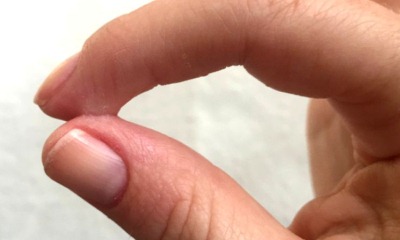 Very often, when working with glue, hands get dirty. Several methods will help to cope with the problem, for example:
Very often, when working with glue, hands get dirty. Several methods will help to cope with the problem, for example:
- using soda gruel;
- cleaning with a pumice stone;
- use of fat - oil, cream, etc .;
- the use of acetone;
- rubbing with alcohol, etc.
Each method has its own pros and cons. When they are used, the skin is adversely affected, therefore, after removing the glue, additional hand care is needed to help the skin to recover.
Several methods will help to remove the adhesive film from the palms or to unstick the fingers, but first, it is better to hold the soiled brushes for 5 minutes in warm soapy water.
General recommendations
The following recommendations will help you to clean various surfaces efficiently:
- It is recommended to carry out technical work with rubber gloves in a well-ventilated area.
- Use for cleaning sharp objects, such as a knife, can only be limited so as not to damage the surface. If the glue has frozen in a volumetric drop, then you can try to cut off the upper part, and remove the remaining trace with solvents.
- Use of harsh solvents and harsh chemicals for cleaning hands is not permitted.
- Any solvent in contact with human skin is harmful to health.
- For mechanical removal of superglue after exposure to solvents, it is recommended to use a plastic scraper, putty knife or plastic knife. Sharp and well-sharpened tools are used only as a last resort.
You will find all the most important and useful information about glue removal here.
Conclusion
You can remove superglue that accidentally left stains using one of the presented methods. In addition to them, it is convenient to use special preparations capable of dissolving the adhesive layer.
And to avoid trouble when working with glue it is advisable to cover surfaces that may be stained and wear gloves.

